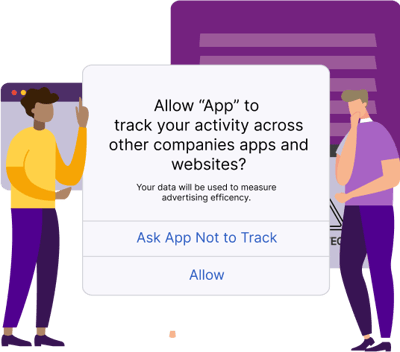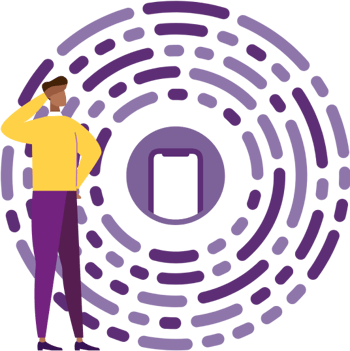NEW LAUNCH: Weill Cornell Medicine's Maya app is now available for Android!
NEW LAUNCH: Weill Cornell Medicine's Maya app is now available for Android!
When it comes to technology, the only constant is change. But some changes cause more noise than others, and over one year ago, that was especially true with the release of iOS 14.5 with App Tracking Transparency measures (also known as ATT).
The update certainly resulted in a fair share of grumbles, particularly among digital advertisers. At Heady, we believe in not just acknowledging but embracing changes in tech and staying ahead of the curve. We also advocate for enhanced digital privacy, so we looked at the release as a good thing. Not just for consumers and privacy advocates, but for the industry as a whole.
It’s one year later, so we’re asking: Were we right to look on the bright side?
Long story short: Each iOS device is assigned a unique and random Identifier for Advertisers (IDFA), which previously enabled advertisers to target ads and track their effectiveness at an individual level. But as of late April 2021, users receive a notification to give an app permission to track them. With the move from automatic IDFA tracking to opt-in, Apple essentially turned the faucet off when it comes to individualized user data.

Ever since Apple made the announcement, there has been a lot of discussion about what these updates mean from an advertising perspective. Now that users can easily understand and control whether or not an app is tracking them, there were predictions of low opt-in rates, which could impact the accuracy of ad targeting, ad efficacy measurements, as well as ad campaign optimization.
Benchmarks shifted, key performance indicators changed, and some brands had to adjust to Apple’s new recommended targeting, such as making use of the Store Kit Ad Network (or SKAd Network) for ad attribution at an aggregate level.
According to the New York Times, statistics from Flurry Analytics noted that only 4% of people preemptively turned off the tracking system for all apps, and as of December 2021, AppsFlyer saw that most app categories saw around 40% of users opting in to tracking.
Those are some pretty solid numbers, which reaffirms my feelings from last year that creating an excellent app experience can build brand loyalty and reinforce consumer trust. If users understand how their data will be used, and have positive associations with the app, they may feel more comfortable allowing the app to track their activity.
The steps below will help your brand navigate Apple’s mobile privacy changes, and will also put you in a forward-thinking mindset, because you can be sure that privacy updates will continue to be implemented as the years go on.
At an All Things Digital conference in 2010, Apple’s own Steve Jobs said, “I believe people are smart and some people want to share more data than other people do. Ask them. Ask them every time. Make them tell you to stop asking them if they get tired of your asking them. Let them know precisely what you’re going to do with their data.”
That notion still holds true today. Apps can make a case for why users should allow the IDFA — take advantage of additional screens to offer transparency into the tracking process and build an honest relationship with your app users. It’s also a great idea to A/B test and retest the data request screen to see what messaging resonates.

Brands should collect more first-party data and personalize consumers’ experiences within their apps. Being in the industry for 10 years, I’ve noticed that personalization often takes a back seat to acquisition. Anecdotally, I get the most ads from brands that I already engage with frequently. Maybe instead of showing me an ad, they could personalize my experience both in the app and at other touchpoints to ensure I keep coming back. The same applies to in-app campaigns.
Considered and personalized activations that offer some value to the user are more likely to create retention (on this point, check out Heady’s App Management System). For example, say I’m using a real estate app to find an apartment in Brooklyn. They could send me emails with news about the neighborhoods I’m interested in, show me in-app content about pricing trends, and default my search to the neighborhoods I’d previously looked into). Then, they could send push notifications if the asking rent drops on an apartment I’ve favorited — making it easier for me to act fast in the competitive New York real estate market.

Before all of the buzz around iOS 14.5, there was iOS 14, which introduced App Clips—an excellent solution for businesses to acquire new users that puts the actual app experience in the spotlight. An App Clip is a small part of your app that appears without a need to download and at moments of need throughout users’ day-to-day lives. Users are offered a full app download after they’ve experienced partial functionality through the App Clip.
App Clips can help with conversion, reach, and, importantly, customer satisfaction. They have valuable use cases in every industry, from finance to industrial product supply to music—really any app that would benefit from lowering its barrier to entry.

Consumers don’t like the fact that their personal information is being commoditized and sold without their knowledge and without them entirely understanding how the whole process works. Mobile privacy updates are moves toward changing that. And while I don’t wish to downplay the shift this has already caused and will continue to cause to advertising plans, app creators and brands have every reason to take this as an opportunity to innovate, to build high quality apps, and to reimagine the app experience from a user-first perspective.
Test more, personalize more. Consider this a chance to double-down on what consumers appreciate and enjoy about your product, and the platforms and environments in which they experience it. In short, put humanity back into the user experience.
%201-1.png?width=58&name=image0%20(1)%201-1.png)
Author
Rahul Khosla

Our emails are (almost) as cool as our digital products.
Your phone will break before our apps do.

© 2026, Heady LLC.